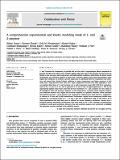| dc.contributor.author | Dong, Shijun | |
| dc.contributor.author | Zhang, Kuiwen | |
| dc.contributor.author | Ninnemann, Erik M. | |
| dc.contributor.author | Najjar, Ahmed | |
| dc.contributor.author | Kukkadapu, Goutham | |
| dc.contributor.author | Baker, Jessica | |
| dc.contributor.author | Arafin, Farhan | |
| dc.contributor.author | Wang, Zhandong | |
| dc.contributor.author | Pitz, William J. | |
| dc.contributor.author | Vasu, Subith S. | |
| dc.contributor.author | Sarathy, S. Mani | |
| dc.contributor.author | Senecal, Peter K. | |
| dc.contributor.author | Curran, Henry J. | |
| dc.date.accessioned | 2021-01-11T08:39:56Z | |
| dc.date.available | 2021-01-11T08:39:56Z | |
| dc.date.issued | 2020-10-15 | |
| dc.identifier.citation | Dong, Shijun, Zhang, Kuiwen, Ninnemann, Erik M., Najjar, Ahmed, Kukkadapu, Goutham, Baker, Jessica, Arafin, Farhan, Wang, Zhandong, Pitz, William J., Vasu, Subith S., Sarathy, S. Mani, Senecal, Peter K., Curran, Henry J. (2021). A comprehensive experimental and kinetic modeling study of 1- and 2-pentene. Combustion and Flame, 223, 166-180. doi:https://doi.org/10.1016/j.combustflame.2020.09.012 | en_IE |
| dc.identifier.issn | 0010-2180 | |
| dc.identifier.uri | http://hdl.handle.net/10379/16444 | |
| dc.description.abstract | 1- and 2-pentene are components in gasoline and are also used as representative alkene components in gasoline surrogate fuels. Most of the available ignition delay time data in the literature for these fuels are limited to low pressures, high temperatures and highly diluted conditions, which limits the kinetic model development and validation potential of these fuels. Therefore, ignition delay time measurements under engine-like conditions are needed to provide target data to understand their low-temperature fuel chemistry and extend their chemical kinetic validation to lower temperatures and higher pressures. In this study, both a high-pressure shock tube and a rapid compression machine have been employed to measure ignition delay times of 1- and 2-pentene over a wide temperature range (60 0-130 0 K) at equivalence ratios of 0.5, 1.0 and 2.0 in 'air', and at pressures of 15 and 30 atm. At high-temperatures (> 900 K), the experimental ignition delay times show that the fuel reactivities of 1and 2-pentene are very similar at all equivalence ratios and pressures. However, at low temperatures, 1-pentene shows negative temperature coefficient behavior and a higher fuel reactivity compared to 2-pentene. Moreover, carbon monoxide time-histories for both 1- and 2-pentene were measured in a high-pressure shock tube for a stoichiometric mixture at 10 atm and at high temperatures. Furthermore, species versus temperature profiles were measured in a jet-stirred reactor at = 1.0 and 1 atm over a temperature range of 70 0-110 0 K. All of these experimental data have been used to validate the current chemistry mechanism. Starting from a published pentane mechanism, modifications have been made to the 1and 2-pentene sub-mechanisms resulting in overall good predictions. Moreover, flux and sensitivity analyses were performed to highlight the important reactions involved in the oxidation process. (C) 2020 The Authors. Published by Elsevier Inc. on behalf of The Combustion Institute. This is an open access article under the CC BY license. | en_IE |
| dc.description.sponsorship | The authors at NUI Galway recognize funding support from Science Foundation Ireland (SFI) via project number 16/SP/3829 and also funding from Computational Chemistry LLC. The work at LLNL was performed under the auspices of the U.S. Department of Energy (DOE) by Lawrence Livermore National Laboratory under Contract DE-AC52-07NA27344 and was conducted as part of the Co-Optimization of Fuels & Engines (Co-Optima) project sponsored by the DOE Office of Energy Efficiency and Renewable Energy (EERE), Bioenergy Technologies and Vehicle Technologies Offices. The work at KAUST was supported by the KAUST Clean Fuels Consortium (KCFC) via its Office of Sponsored Research and member companies. This work at UCF was conducted as part of the Co-Optimization of Fuels & Engines (Co-Optima) project sponsored by the U.S. Department of Energy (DOE) Office of Energy Efficiency and Renewable Energy (EERE) [grant numbers DE-EE007982, DE-EE007984]. | en_IE |
| dc.format | application/pdf | en_IE |
| dc.language.iso | en | en_IE |
| dc.publisher | Elsevier | en_IE |
| dc.relation.ispartof | Combustion And Flame | en |
| dc.rights | Attribution-NonCommercial-NoDerivs 3.0 Ireland | |
| dc.rights.uri | https://creativecommons.org/licenses/by-nc-nd/3.0/ie/ | |
| dc.subject | IGNITION DELAY TIMES | en_IE |
| dc.subject | PRESSURE SHOCK-TUBE | en_IE |
| dc.subject | HIGH-TEMPERATURE | en_IE |
| dc.subject | RATE RULES | en_IE |
| dc.subject | OXIDATION | en_IE |
| dc.subject | ISOMERS | en_IE |
| dc.subject | AUTOIGNITION | en_IE |
| dc.subject | COMBUSTION | en_IE |
| dc.subject | 1-PENTENE | en_IE |
| dc.subject | RADICALS | en_IE |
| dc.title | A comprehensive experimental and kinetic modeling study of 1-and 2-pentene | en_IE |
| dc.type | Article | en_IE |
| dc.date.updated | 2021-01-07T11:04:29Z | |
| dc.identifier.doi | 10.1016/j.combustflame.2020.09.012 | |
| dc.local.publishedsource | https://doi.org/10.1016/j.combustflame.2020.09.012 | en_IE |
| dc.description.peer-reviewed | peer-reviewed | |
| dc.contributor.funder | Science Foundation Ireland | en_IE |
| dc.contributor.funder | Computational Chemistry LLC | en_IE |
| dc.internal.rssid | 24253789 | |
| dc.local.contact | Henry Curran, Dept Of Chemistry, Room 215, Arts/Science Building, Nui Galway. 3856 Email: henry.curran@nuigalway.ie | |
| dc.local.copyrightchecked | Yes | |
| dc.local.version | PUBLISHED | |
| nui.item.downloads | 173 | |


